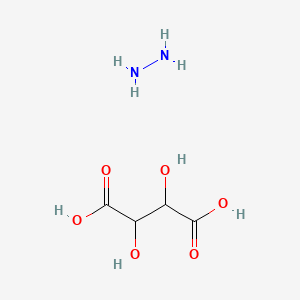



1. Hydrazine
2. Hydrazine Dihydrochloride
3. Hydrazine Hydrate
4. Hydrazine Monohydrate
5. Hydrazine Mononitrate
6. Hydrazine Nitrate
7. Hydrazine Phosphate (1:1)
8. Hydrazine Phosphate (2:1)
9. Hydrazine Sulfate
10. Hydrazine Sulfate (1:1) Monosodium Salt
11. Hydrazine Sulfate (2:1)
12. Segidrin
1. 634-62-8
2. Hydrazinetartrate
3. 2,3-dihydroxybutanedioic Acid;hydrazine
4. Hydrazine, (2r,3r)-2,3-dihydroxybutanedioate (1:1)
5. Weinsaurem Hydrazin
6. Schembl2276011
| Molecular Weight | 182.13 g/mol |
|---|---|
| Molecular Formula | C4H10N2O6 |
| Hydrogen Bond Donor Count | 6 |
| Hydrogen Bond Acceptor Count | 8 |
| Rotatable Bond Count | 3 |
| Exact Mass | 182.05388604 g/mol |
| Monoisotopic Mass | 182.05388604 g/mol |
| Topological Polar Surface Area | 167 Ų |
| Heavy Atom Count | 12 |
| Formal Charge | 0 |
| Complexity | 134 |
| Isotope Atom Count | 0 |
| Defined Atom Stereocenter Count | 0 |
| Undefined Atom Stereocenter Count | 2 |
| Defined Bond Stereocenter Count | 0 |
| Undefined Bond Stereocenter Count | 0 |
| Covalently Bonded Unit Count | 2 |
Antineoplastic Agents
Substances that inhibit or prevent the proliferation of NEOPLASMS. (See all compounds classified as Antineoplastic Agents.)
Carcinogens
Substances that increase the risk of NEOPLASMS in humans or animals. Both genotoxic chemicals, which affect DNA directly, and nongenotoxic chemicals, which induce neoplasms by other mechanism, are included. (See all compounds classified as Carcinogens.)